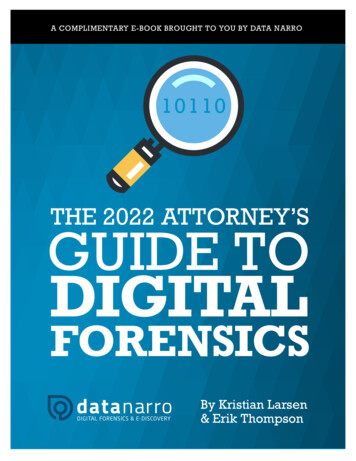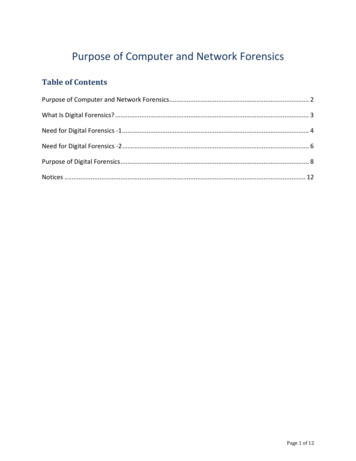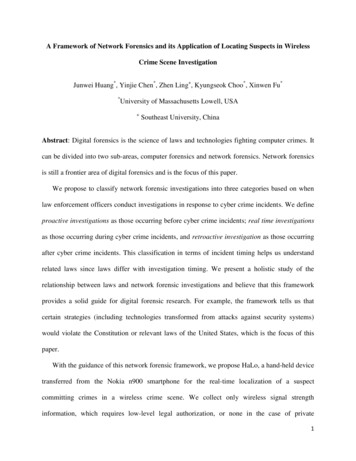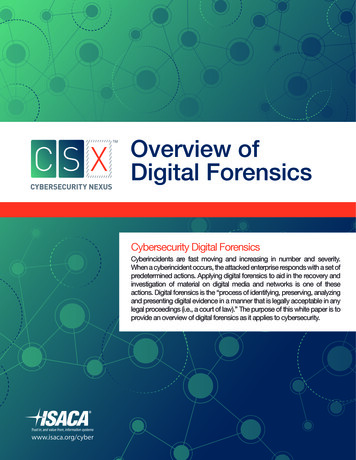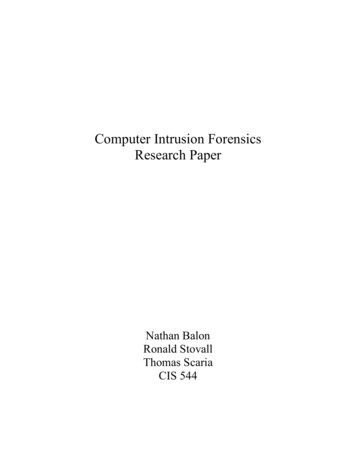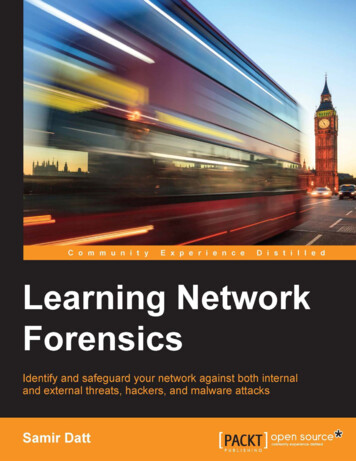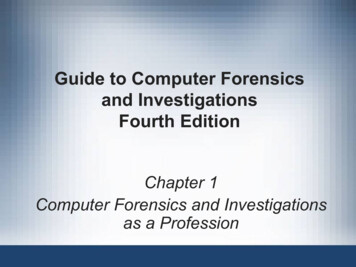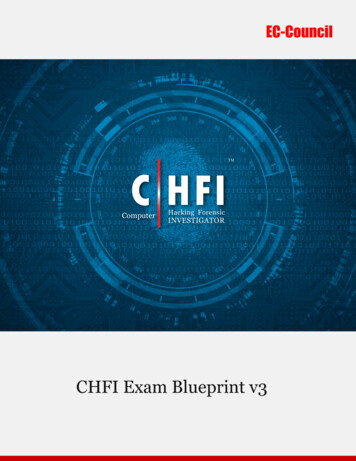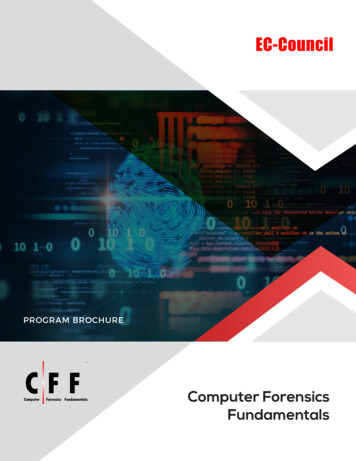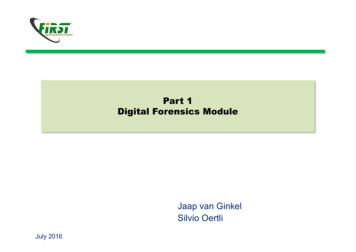
Transcription
Part 1Digital Forensics ModuleJaap van GinkelSilvio OertliJuly 2016
Agenda Part 1: Introduction– Definitions / Processes Part 2: Theory in Practice– From planning to presentation Part 3: Live Forensics– How to acquire a memory image– Investigate the image Part 4: Advanced Topics– Tools– Where to go from here– And more2
Disclaimer A one or two-day course on forensics will not make you a forensicsexpert.– Professionals spend most of their working time performing forensic analysis andthus become an expert. All we can offer is to shed some light on a quickly developing andbroad field and a chance to look at some tools.We will mostly cover Open Source Forensic Tools.3
IntroductionForensics in History4
Forensics – History2000 BC1200 BC5
IntroductionDefinitions / Processes6
Forensics – The Fielddigital forensicsComputer ForensicsDisk ForensicsMobil ForensicsMemory ForensicsDatenbase ForensicsLive ForensicsNetwork Forensics7
Forensics - Definition Digital Forensics [1]:– Digital forensics (sometimes known as digital forensic science) is a branch offorensic science encompassing the recovery and investigation of material foundin digital devices, often in relation to computer crime. Computer Forensics [2]:– Computer forensics (sometimes known as computer forensic science) is abranch of digital forensic science pertaining to legal evidence found in computersand digital storage media. The goal of computer forensics is to examine digitalmedia in a forensically sound manner with the aim of identifying, preserving,recovering, analyzing and presenting facts and opinions about the information.8
Forensics - Definitions Network Forensics [3]:– Network forensics is a sub-branch of digital forensics relating to the monitoringand analysis of computer network traffic for the purposes of informationgathering, legal evidence, or intrusion detection.[1] Unlike other areas of digitalforensics, network investigations deal with volatile and dynamic information.Network traffic is transmitted and then lost, so network forensics is often a proactive investigation. Database Forensics [4]:– Database Forensics is a branch of digital forensic science relating to theforensic study of databases and their related metadata. Mobile Forensics [5]:– Mobile device forensics is a branch of digital forensics relating to recovery ofdigital evidence or data from a mobile device under forensically soundconditions. The phrase mobile device usually refers to mobile phones; however, itcan also relate to any digital device that has both internal memory andcommunication ability.9
What it’s not like.Image Source: http://www.clickcultural.com.br/foto/10/fto thb 15510.jpg10
Locard’s Exchange Principle Every contact leaves a trace– Presence or absence of something– Either physical or electronicallyCrime SceneEvidenceVictimSuspectSource: [3]11
Locard’s Exchange Principle“Wherever he steps, whatever he touches, whatever he leaves, evenunconsciously, will serve as a silent witness against him. Not onlyhis fingerprints or his footprints, but his hair, the fibers from hisclothes, the glass he breaks, the tool mark he leaves, the paint hescratches, the blood or semen he deposits or collects. All of theseand more, bear mute witness against him. This is evidence thatdoes not forget. It is not confused by the excitement of the moment.It is not absent because human witnesses are. It is factual evidence.Physical evidence cannot be wrong, it cannot perjure itself, itcannot be wholly absent. Only human failure to find it, study andunderstand it, can diminish its value.”Source: [7]12
Daubert Standard (US)“The Daubert standard is a rule of evidence regarding theadmissibility of expert witnesses' testimony during UnitedStates federal legal proceedings. Pursuant to this standard, aparty may raise a Daubert motion, which is a special case ofmotion in limine raised before or during trial to exclude thepresentation of unqualified evidence to the jury.”Source: [8]Goal: No junk science in a courtroomWay: Adhere to scientific standards13
Daubert Standard (US)Court defined "scientific methodology”: Formulate hypotheses andconduct experiments to prove or falsify the hypotheses.– Empirical testing: the theory or technique must be falsifiable, refutable, andtestable.– Subjected to peer review and publication.– Known of potential error rate.– The existence and maintenance of standards and controls concerning itsoperation.– Degree to which the theory and technique is generally accepted by the relevantscientific community.14
Principles (UK)Four principles according to ACPO for the police [11]:1. No action taken by law enforcement agencies or their agents should changedata held on a computer or storage media which may subsequently be reliedupon in court.2. In circumstances where a person finds it necessary to access original data heldon a computer or on storage media, that person must be competent to do soand be able to give evidence explaining the relevance and the implications oftheir actions.3. An audit trail or other record of all processes applied to computer-basedelectronic evidence should be created and preserved. An independent thirdparty should be able to examine those processes and achieve the same result.4. The person in charge of the investigation (the case officer) has overallresponsibility for ensuring that the law and these principles are adhered to.15
Five Ws (and one H) –––––– ?Method for getting the full story on something by asking the followingquestions:Who is it about?What happened?Where did it take place?When did it take place?Why did it happen?How did it happen?These questions have to be addressed in the report.16
Legal Aspects - IANAL Follow the law of the relevant jurisdiction– Every jurisdiction has different rules that have tobe considered– Sovereign vs. Non-sovereign investigations E.g. the police has the rights for house searches undercertain restrictions), whereas you or your organization donot have that right. Permission for search and seizure (house searches / private property) Follow forensic standards– International or local common “scientific” standards Organizational Policies– Internal regulations that apply also in forensic investigations Declaration of ConfidentialityLetter of Intent17
Legal Risks Data protection– Privacy rights Labour/Employment Law– Might not access folders marked as private even on company-owned computers– CCTV surveillance not permitted in some jurisdictions– Content inspection might be illegal (eg. E-Mail) Company Policies– Devices can be use for private stuff (privacy) Pornographic material– Civilians might not hold or distribute pornographic material Technical possibilities for forensic analysis go far beyond whatis legally possible!18
Legal – General Advice If in doubt: Ask your lawyer(s) / your legal department Technically– Do not press a single key if in doubt (not even the power switch)– Ask your forensics specialist– Avoid altering evidence as much as possible19
IT Security in Forensics Prevent infection of Analysis System– Suspect device might contain malware– Separate Analysis Lab Infrastructure (including LAN and Internet Connectivity) Data Security––––ClassificationNeed-to-know principle appliesStore evidence in a safe when not in useOnly authorized personnel with the necessary clearance has access to evidence/ lab– Same rules apply for backups20
Part 1ReferencesApril 2012
References - Definitions123456Digital Forensics: http://en.wikipedia.org/wiki/Digital forensicsComputer Forensics: http://en.wikipedia.org/wiki/Computer forensicsMobile Device Forensics: http://en.wikipedia.org/wiki/Mobile device forensicsDatabase Forensics: http://en.wikipedia.org/wiki/Database forensicsNetwork Forensics: http://en.wikipedia.org/wiki/Network forensicsChain of Custody: http://en.wikipedia.org/wiki/Chain of custody43
References – Standards & Guidelines7891011121314Loccard‘s Exchange Principle:http://en.wikipedia.org/wiki/Locard%27s exchange principleDaubert Standard: http://en.wikipedia.org/wiki/Daubert standardElectronic Crime Scene Investigation, Second pdfFIRST Responders Guide to Computer Forensics:http://www.cert.org/archive/pdf/FRGCF v1.3.pdfGood Practice Guide for Computer-Based. Electronic Evidence:http://www.7safe.com/electronic evidence/ACPO guidelines computer evidence.pdfNIST Guide to Integrating Forensic Techniques into Incident s/800-86/SP800-86.pdfRFC 3227 - Guidelines for Evidence Collection and Archiving:http://tools.ietf.org/html/rfc3227ISO 27037 - Guidelines for identification, collection and/or acquisition andpreservation of digital evidence (Due 2012-10-26):http://www.iso.org/iso/iso catalogue/catalogue tc/catalogue detail.htm?csnumber 4438144
References – Forensics Tools15161718192021222324252627DEFT Linux: http://www.deftlinux.net/SANS SIFT: oadsCAINE: http://www.caine-live.net/Backtrack Linux: http://www.backtrack-linux.org/FCCU Forensic Boot CD: http://www.lnx4n6.be/index.phpeFence Helix: http://www.e-fense.com/products.phpSleuthkit / Autopsy: http://www.sleuthkit.org/index.phpPyFLAG: http://www.pyflag.net/cgi-bin/moin.cgiPTK: http://ptk.dflabs.com/DFF: http://www.digital-forensic.org/Encase: http://www.guidancesoftware.com/FTK: ftkX-Ways Forensics: http://www.x-ways.net/forensics/index-m.html45
forensics, network investigations deal with volatile and dynamic information. Network traffic is transmitted and then lost, so network forensics is often a pro-active investigation. Database Forensics [4]: -Database Forensicsis a branch of digital forensic sciencerelating to the forensic study of databasesand their related metadata.
